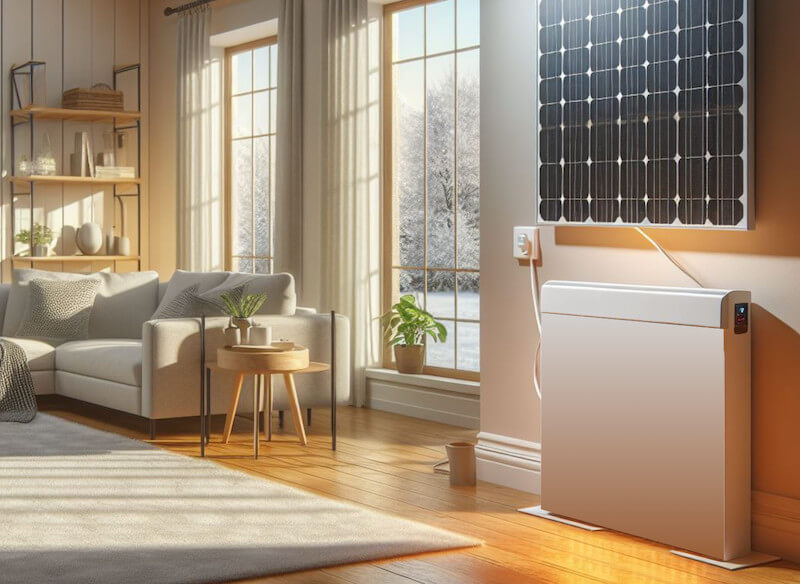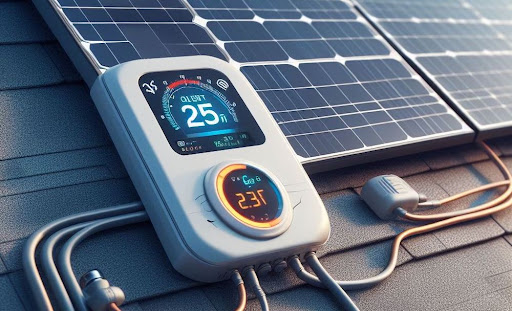The need for energy efficiency and eco-friendly solutions has never been more critical in an era of rising energy costs and growing environmental concerns. Step into the future as we unravel the compelling benefits of infrared heating and solar power – two innovative technologies that are reshaping the world of domestic and industrial heating.
Table of Contents
Overview of Infrared Heating & Solar Panels
Advantages of Infrared Heating & Solar Panels
Types of Infrared Heating & Solar Systems
Choosing the Right System for Your Needs
Find out how these advanced solutions not only save you cost but also help to preserve our planet, offering unparalleled levels of comfort and convenience along the way. There’s no better time than now to make the smart switch!
Overview of Infrared Heating & Solar Panels
Infrared heating, coupled with solar panels, offers a revolutionary solution for energy-efficient and eco-friendly heating in homes and other buildings. By harnessing the power of infrared radiation which ensures a more even distribution of heat and minimises energy wastage, this innovative technology transforms the way we think about traditional heating systems.
Imagine stepping into a room heated by infrared panels. Rather than feeling a rush of hot air or waiting for the entire space to warm up, you immediately sense a gentle warmth on your skin as the infrared waves penetrate you. Think how the sun’s heat can warm you up even if the outside temperature is cold!
One significant advantage of infrared heating is its compatibility with solar panels. As the demand for sustainable energy solutions grows, more homeowners are turning to solar systems to power their homes. Infrared heating can efficiently utilise the electricity generated by these solar panels, making it an environmentally friendly and cost-effective option.

To achieve optimal results with infrared heating and solar panels, it is recommended to work with reputable companies specialising in both technologies.
Now that we have a comprehensive understanding of infrared heating and its compatibility with solar panels, let’s delve into the eco-friendly and efficient functioning of this innovative duo.
- According to a report by the International Energy Agency (IEA), solar could generate up to 16% of the world’s electricity by 2050.
- Infrared heaters are nearly 100% efficient, meaning almost all energy consumed is converted into heat, according to the U.S Department of Energy.
- Research published in Renewable and Sustainable Energy Reviews demonstrated that supplementing solar panels with infrared heaters can result in an approximate 25% reduction in annual electricity consumption for home heating purposes.
- An IR-Bau study conducted by HTWG-Konstanz found that Installing IR +Solar was significantly more cost effective than installing other electrical solutions such as ASHP with Solar when Cap Ex is considered.
-
Eco-friendly and Efficient Functioning
Infrared heating with solar systems not only offers energy-efficient warmth but also contributes to a more sustainable future. Unlike traditional heating methods that rely on burning fuels or consuming large amounts of electricity, infrared heaters operate at low wattage levels, reducing overall energy consumption. This low-wattage characteristic makes them an ideal choice for pairing with solar panels, as they can be powered by the clean and renewable energy generated by the panels.
When combined with solar panels, infrared heating systems benefit from optimum energy efficiency. Solar panels have the ability to generate electricity from sunlight, which can then be used to power the infrared heaters. This means you can heat your home using only the electricity produced by your solar panels, making them environmentally friendly heaters. This resulting in substantial cost savings and a reduced environmental impact.
Additionally, infrared heating works by directly warming the objects in a room rather than solely relying on heating the air. This approach provides several advantages, such as improved thermal comfort and reduced heat loss through air circulation. By targeting the objects’ surfaces, infrared radiation ensures efficient heat transfer that effectively warms up the space without wasting energy on unused areas.
Consider an older home with poor insulation where conventional heating systems struggle to maintain warmth due to significant heat loss. In such cases, using infrared heaters can help combat dampness issues and create a more comfortable living environment by efficiently heating solid surfaces like walls and floors.
Furthermore, implementing smart controls and integrating your infrared heating system into a smart home setup allows for easy management of temperature settings. You can effortlessly adjust the heat based on occupancy levels or time schedules, optimising energy usage and minimising waste.
By embracing infrared heating with solar systems, you not only enjoy comfortable warmth and reduced energy bills but also contribute towards building a greener world. The combination of efficient technology, renewable energy, and smart controls make it an environmentally conscious choice for sustainable and cost-effective heating.
Advantages of Infrared Heating & Solar Panels
When it comes to heating your home or office in an energy-efficient and eco-friendly way, infrared heating and solar panels offer a myriad of advantages. Let’s explore the benefits of these two innovative technologies that harness the power of renewable energy.
One of the standout advantages of infrared heating is its incredible energy efficiency. Unlike conventional heating systems that rely on warming the air, infrared heaters emit infrared radiation that directly heats surfaces and objects in a room. This targeted heat transfer ensures there is minimal energy wastage, as no heat is lost in heating the surrounding air or empty spaces. As a result, infrared heaters can be up to 30% more efficient than traditional heating systems.
Furthermore, infrared heaters are renowned for their even heat distribution throughout a space. By directly hitting surfaces with radiant heat, hot spots and cold zones are reduced significantly. This creates a comfortable and pleasant living environment where you can enjoy consistent warmth throughout the room. Imagine snuggling up on your couch without worrying about chilly corners or stuffy areas.
But energy efficiency and even heat distribution aren’t the only perks of infrared heating. These highly efficient heaters also have health-friendly properties that benefit both you and the environment. Infrared heaters do not cause air movement or dust turbulence, making them suitable for allergy sufferers who may be sensitive to airborne particles.
Cost Benefits & Energy-Efficiency
Solar panels harness sunlight to generate electricity, offering significant advantages in terms of cost savings and energy-efficiency. By harnessing this renewable energy source, you can reduce your reliance on traditional power grids and tap into the abundance of freely available sunlight.
Let’s consider a scenario where you have solar panels installed on your rooftop. During the day, these panels capture sunlight and convert it into electricity that can power your home or business. Any excess electricity produced can be fed back into the grid, allowing you to earn credits or receive compensation for the energy you contribute. This not only lowers your electric bills but also provides an opportunity to make some additional income.
Moreover, solar panels require minimal maintenance once installed, making them a cost-effective investment in the long run. They have a lifespan of around 25-30 years and come with warranties that ensure their performance over time. With proper care, routine cleaning, and occasional inspections, solar panels can continue to generate clean and sustainable energy for decades.
In addition to the financial benefits, solar panels significantly contribute to reducing our carbon footprint by generating clean and renewable energy. By relying on solar power instead of fossil fuels, you are actively promoting a greener future. This move towards sustainable energy not only helps combat climate change but also ensures a healthier environment for generations to come.
An added benefit is that they align with our infrared products as well such as our PowerBoard™️ systems.
Minimal Environmental Impact
In today’s world, where environmental consciousness is on the rise, finding energy-efficient and eco-friendly solutions for heating and powering our homes is becoming increasingly important. This is where infrared heating and solar systems shine, offering minimal environmental impact compared to traditional heating methods.
When it comes to infrared heating, these systems use a heating element that emits infrared radiation, directly warming people and objects. This targeted approach ensures efficiency and reduces energy consumption, making it an excellent choice for environmentally conscious individuals. Infrared systems are relatively simple and lack a lot of small individual components decreasing their environmental impact when compared with say underfloor heating or central ac systems.
On the other hand, solar systems harness the power of the sun to generate electricity. By installing solar panels on your roof or in your garden, you can tap into an abundant source of renewable energy. Solar power not only reduces your reliance on fossil fuels but also helps reduce greenhouse gas emissions that contribute to climate change.
Types of Infrared Heating & Solar Systems
Now that we understand the minimal environmental impact of these energy-efficient solutions let’s explore the types of infrared heating and solar systems available for different indoor and outdoor needs.
Indoor vs. Outdoor Systems
Infrared heating systems come in two primary forms: indoor and outdoor. Each system has its unique advantages and considerations to keep in mind when choosing the best option for your needs.
When it comes to indoor systems, they are specifically designed to provide economical heating solutions within the confines of your home or office space. The heat generated by indoor infrared panels is gentle yet effective, allowing for even distribution without creating uncomfortable drafts.
On the other hand, outdoor infrared heating systems are tailored to provide warmth and comfort in open-air environments such as patios, terraces, or outdoor seating areas. These systems operate efficiently under different weather conditions, including wind and rain, making them highly versatile for outdoor spaces.
The key advantage of outdoor systems lies in their ability to focus heat where it’s needed most, allowing you to enjoy your outdoor areas year-round. Whether you’re hosting a dinner party on your patio or spending quality time with loved ones around a fire pit, outdoor infrared heaters can create a cozy ambiance that extends well into colder seasons.
It’s worth noting that both indoor and outdoor infrared heating systems are energy-efficient solutions that can help reduce electricity consumption and minimise environmental impact. They offer an eco-friendly alternative to traditional heating methods such as gas central heating or electric radiators.
Choosing the Right System for Your Needs
Now that we understand the distinction between indoor and outdoor infrared heating systems, let’s explore how you can choose the right system for your specific needs.
The selection process might seem overwhelming at first, but by considering a few key factors, you can make an informed decision:
- Location and Purpose: Determine where you primarily need heating and what purpose the heating system will serve. Are you looking to warm up specific rooms in your home or create a comfortable outdoor living space?
- Size and Power: Consider the size of the area you intend to heat and the power requirements to ensure optimal performance. Larger spaces may require multiple panels or higher wattage heaters for efficient coverage.
- Style and Design: Evaluate the aesthetics of your space and choose infrared heaters that complement the overall design. There are various styles, finishes, and mounting options available to blend seamlessly with any decor.
- Control Options: Examine the control options provided by different systems. Some infrared heaters offer advanced features like remote control, programmable timers, or compatibility with smart home automation for added convenience.
- Budget and Cost-effectiveness: Assess your budgetary constraints and compare prices, warranties, and energy efficiency ratings between different infrared heating systems to find the best cost-effective solution.
By carefully assessing these aspects, you can confidently select the most suitable indoor or outdoor infrared heating system that aligns with your needs, preferences, and budgetary considerations.

